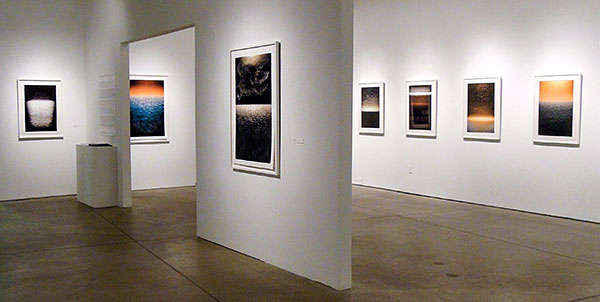Caroline Wright: On Tom Condon’s Idiopathic Aura
Curator’s Commentary
. . .what a colossal and complicated achievement normal vision is, as the brain constructs a visual world in which color and movement and size and form and stability are all seamlessly meshed and integrated.
—Oliver Sacks, Hallucinations
Tom Condon’s latest work celebrates the “complicated achievements” of the human eye by exploring the internal mechanics and sensory wonders of human sight. When he was in his early teens, Condon experienced impaired vision and temporary blindness. An onset of Idiopathic Pseudotumor Cerebri, triggered by an excess of spinal fluid, caused him to spend the latter half of his childhood in and out of doctors’ offices and hospitals undergoing vision tests. Since his recovery eighteen years ago, he continuously fears returning to a visually impaired state.
 |
| Idiopathic Aura January 24, 2014–March 17, 2014, Visual Arts Center, Richmond, Virginia |
This photographic series examines the psychological and physical effects of Condon’s personal experience through the digital documentation of a Braille catalog. Photographed in shifting light with shallow focus and removed from its original context, the tactile language is transformed into a visual landscape. Trace oils and fingerprints on the original Braille inspired Condon to make each print unique. He applied cold wax directly to the surface of each photograph by hand, saturating each image with his own fingertips before painting over the wax with dry pigments and metallic powders. Subsequently, Condon melted and blended the wax and powders with a flame torch, and then finished each photograph with an elusive surface that animates the image and refracts environmental light.
| Roll over the image below to magnify detail. |
| Read the Stars, 2012 Archival pigment print on velvet paper, infused with cold wax and metallic powders 30 x 20 in. |
Condon’s Braille series emphasizes the similar working mechanisms of the traditional camera and the human eye—both ultimately dependent on light. The glowing spotlights, atmospheric “floaters,” and colorful auras that hover above and below implied horizons evoke the intense sensations and radiating colors Condon remembers from the moment he regained his sight.
With the purpose of extending his Braille photographs into an exploration of color and vision, Condon documented hundreds of palette studies at a local screen printing shop. He photographed test screens covered in small samples of inks before they were rinsed and discarded. From this collection of images, Condon developed a series of abstract compositions in Photoshop that vibrate with intensity through form and color and seem to suggest terrain mapping, gene sequencing, even eye charts. To create “excessive visual stimulation” in these prints, Condon manipulated the surface with everyday materials such as crayons and Sharpie markers. Consequently, layers of ink and wax bleed in and out of focus, making the viewer question whether the image was made by hand, machine, or is a product of an optical, perceptual disturbance.
| Roll over the image below to magnify detail. |
| Opponent Process, 2013 Archival pigment print and crayon on paper 30 x 22 in. |
The titles of the works in this second series are scientific terms assigned to the different ways our brains process visual information, experience optical illusions, or understand color. Condon explains
Color is more elusive than any other visual input. It slips and slides between categories, names, temperatures, identities. Color is affected by its proximity to another color and by its physical environment—the type of light, clarity of atmosphere, etc. When I experience color, I am immediately reminded that my eyes are not transmitting the same information as yours.
Condon’s photographs place a focal point on our visual sensitivities. Through blurred, saturated, ambiguous, familiar, and sometimes disorienting images, his work invites the viewer to contemplate and acknowledge the intimacy of looking. ![]()
Caroline Wright is the Director of Exhibition Programming for the Visual Arts Center of Richmond.
Idiopathic Aura: Artist’s Introduction ![]()
Caroline Wright: On Condon’s Idiopathic Aura
Idiopathic Aura